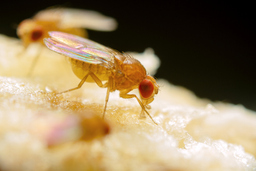High Resolution Capillary Based Calorimetry for Measuring Heat Output from Biological Systems
TECHNOLOGY NUMBER: 7815

OVERVIEW
A direct calorimetric platform to quantify basal metabolic rate of the fruit fly- Tracks heat output in Drosophila melanogaster at a time resolution of less than 1 minute
- Enables systematic studies of the effects of diet and gene expression on metabolism
BACKGROUND
Human metabolism influences daily functioning and can be linked to obesity-related diseases such as diabetes mellitus. The methods for studying metabolism have historically involved either respirometry or calorimetry analysis. Respirometry calculates an organism's oxygen consumption rate by measuring the decrease in partial pressure of oxygen in a closed system, though it only calculates aerobic metabolic rate and has a slow response time. Calorimetry measures heat production of an organism and captures a total rate which represents both aerobic and anaerobic metabolism. While the fruit fly Drosophila melanogaster has emerged as an important biologic model for studying metabolism owing to their rapid lifespan, similar digestive system as mammals, ease of genetic manipulation, accurate measurements of metabolic rate for such small organisms has proven challenging. As such, a need exists for an apparatus that can measure heat output and thus metabolic rate for Drosophila and other small organisms.
INNOVATION
Researchers have created a direct calorimetry device that calculates metabolic rate by sensitive heat output measurement. This technology provides a new method for measuring metabolism of fruit flies and other small organisms through the use of a direct calorimetry approach. The device utilizes sensitive thermistors in conjunction with real time monitoring equipment to measure heat expenditure while simultaneously allowing researchers to observe behavior associated with changes in metabolic rate. It is capable of providing temperature readings at a resolution of ±30 micro-Kelvin, making it much more sensitive than currently available technologies. The tool supports concurrent measurements on multiple individual fruit flies for improved throughput, it enables systematic studies of the effects of diet and gene expression on metabolism, and it facilitates studies to clarify the link between metabolism and lifespan or aging. Lastly, the method can be adapted to perform long-term measurements to correlate the links between circadian clocks and metabolism by integrating food and environmental stimuli into the apparatus.
-
expand_more mode_edit Inventor (7)Anthony FiorinoChang JiangDakotah ThompsonEdgar MeyhoferPramod Sangi ReddyRohith MittapallySung Hoon Hur
-
expand_more cloud_download Supporting documents (1)Product brochureHigh Resolution Capillary Based Calorimetry for Measuring Heat Output from Biological Systems.pdf